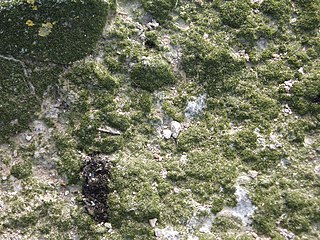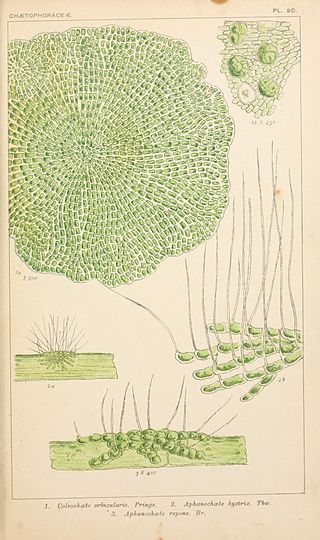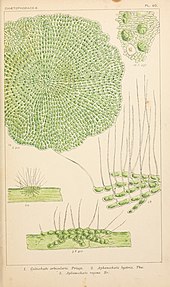
The Chlorophyceae are one of the classes of green algae, distinguished mainly on the basis of ultrastructural morphology. They are usually green due to the dominance of pigments chlorophyll a and chlorophyll b. The chloroplast may be discoid, plate-like, reticulate, cup-shaped, spiral- or ribbon-shaped in different species. Most of the members have one or more storage bodies called pyrenoids located in the chloroplast. Pyrenoids contain protein besides starch. Some green algae may store food in the form of oil droplets. They usually have a cell wall made up of an inner layer of cellulose and outer layer of pectose.

The glaucophytes, also known as glaucocystophytes or glaucocystids, are a small group of unicellular algae found in freshwater and moist terrestrial environments, less common today than they were during the Proterozoic. The stated number of species in the group varies from about 14 to 26. Together with the red algae (Rhodophyta) and the green algae plus land plants, they form the Archaeplastida.

Sphaeropleales is an order of green algae that used to be called Chlorococcales. The order includes some of the most common freshwater planktonic algae such as Scenedesmus and Pediastrum. The Sphaeropleales includes vegetatively non-motile unicellular, colonial, or filamentous taxa. They have biflagellate zoospores with flagella that are directly opposed in direction : Sphaeroplea, Atractomorpha, Neochloris, Hydrodictyon, and Pediastrum. All of these taxa have basal body core connections. Motile cells generally lack cell walls or have only a very fine layer surrounding the cell membrane. Other common characteristics include a robust vegetative cell wall, cup-shaped chloroplasts with large pyrenoids, and relatively large nuclei.

Prasiolales is an order of green algae in the class Trebouxiophyceae. Members of this order are ecologically widespread and are found in freshwater, marine, and terrestrial habitats from the Arctic to the Antarctic.

Chlorellaceae are a family of green algae in the order Chlorellales. About 250 species are currently accepted in the family. Members of the family are distributed worldwide and are common in a variety of freshwater, terrestrial and marine environments.

Ankistrodesmus is a genus of green algae in the family Selenastraceae. It is one of the most common types of phytoplankton in freshwater habitats around the world. The name Ankistrodesmus comes from the Greek roots ankistron, meaning "cross", and desmos, meaning "bond".

Characium is a genus of green algae in the family Characiaceae. It is very commonly found in freshwater habitats, where it is attached to phytoplankton or zooplankton.

Stigeoclonium is a genus of green algae in the family Chaetophoraceae. There are currently 52 accepted species within this group. However, recent phylogenetics have identified that this group is likely polyphyletic and will need reassessment.

Bambusina is a genus of freshwater green algae in the family Desmidiaceae. Bambusina is a cosmopolitan genus, typically associated with acidic and oligotrophic waters. Species of this genus, particularly B. borreri, have been reported in all continents except Antarctica.

Sykidion is a genus of green algae. Pseudoneochloris is a synonym of this genus. As of March 2022, Sykidion was the only genus in the family Sykidiacaeae, which was the only family in the order Sykidiales.
The Mesostigmatophyceae are a class of basal green algae found in freshwater. In a narrow circumscription, the class contains a single genus, Mesostigma. AlgaeBase then places the order within its circumscription of Charophyta. A clade containing Chlorokybus and Spirotaenia may either be added, or treated as a sister, with Chlorokybus placed in a separate class, Chlorokybophyceae. When broadly circumscribed, Mesostigmatophyceae may be placed as sister to all other green algae, or as sister to all Streptophyta.

Chlorokybus is a multicellular (sarcinoid) genus of basal green algae or charophyte. It has been classified as the sole member of the family Chlorokybaceae, which is the sole member of the order Chlorokybales, in turn the sole member of the class Chlorokybophyceae. It grows on soil and rock surfaces, and is rare.
Mesostigma is a genus of unicellular biflagellate freshwater green algae, with a single species Mesostigma viride, covered by an outer layer of basket‐like scales instead of a cell wall. It is the only known genus in the class Mesostigmatophyceae.

The Klebsormidiaceae are a family containing five genera of charophyte green alga forming multicellular, non-branching filaments. The genus Chlorokybus was previously included as well, but this problematic and poorly known genus is now placed in a separate class Chlorokybophyceae.
Cruoriopsis is a genus of non-corraline red algae. It has sometimes been considered a synonym of Cruoriella Crouan & Crouan or part of the larger genus Peyssonnelia.
Chaetosphaeridium is a genus of green algae. Several classifications have been proposed. Its traditional classification is in the order Coleochaetales, related to the genus Coleochaete. AlgaeBase places it in the order Chaetosphaeridiales.

Coleochaetophyceae is a class of charophyte algae related to land plants. There are about 35 known species, and are predominantly found in freshwater where they live periphytic on the surface of aquatic plants, plastic bags and pebbles in the shallow littoral zone of freshwater lakes. These are small disc-shaped or filamentous species, and have true multicellular organisation with sexual and asexual reproduction. The discs never develop beyond a two-dimensional organization. Their mitogenome is the most intron rich organelle among the streptophyte algae.
Pyrenomonas is a genus of cryptomonad.
Wislouchia is a genus of chlorophyte green algae. The name was first published in 2021, as a replacement name for Raciborskiella. As of February 2022, it was the only genus in the family Wislouchiaceae.
Dinema, synonym Dinematomonas, is a genus of flagellated algae in the phylum Euglenozoa.













